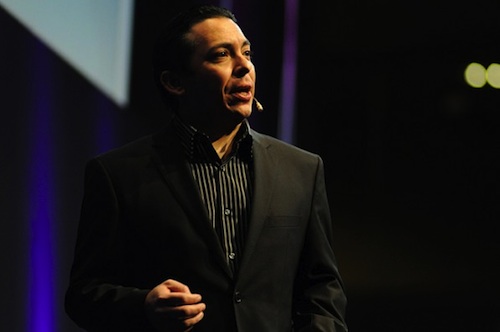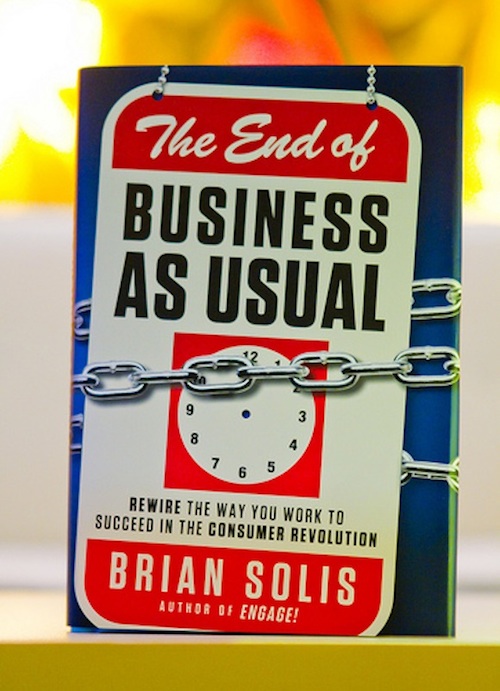Originally posted to Forbes.
Everyone likes to think of themselves as a guru: bloggers, CEOs, even the guy hanging around your local golf shop. But, as any Eastern Studies student will tell you, gurus not only acquire knowledge, they dispense it.
Brian Solis has earned the title of social media guru because he can impart his insight into social media and social marketing in thoughtful, articulate language free of the usual jargon and rhetoric. Too many 2.0 marketers want to aggressively pitch the potential of Facebook pages and Twitter accounts. Brian just wants to talk—about the challenges of social media and the opportunities for shared experiences.
His excellent new book, The End Of Business As Usual, offers both a unique assessment of the accelerating economy and prescriptive approaches business can adopt to succeed in a consumer-empowered marketplace. Brian argues persuasively that tech savvy customers do much more than than simply “consume” new products, they also identify, review and market them to a large social network. He advises companies to develop an infrastructure that can both support these new customers and expand engagement opportunities for old ones.

I talked with Brian about the emergence of the connected consumer, the need for a holistic engagement strategy and the ineffectiveness of common social media engagement metrics. Here’s the result:
Jesse Thomas: You’ve written that social media is about people and their shared experiences, not brands and marketing. In fact, there’s evidence that only one percent of Facebook are even engaging with brand pages. How should brands using social media meaningfully interact with existing and potential customers (or can they)?
Brian Solis: It starts with answering the question of why. Why would people want to engage with your business? So many companies rushed to social networks because they knew customer attention was focused there, but they never studied what it takes to not only attract attention but hold it over time.
Most social media strategies today emanate from the marketing department. In fact, most studies show that the top departments that “own” social media within the organization are 1) Marketing, 2) Marketing Communication, and 3) Public Relations. Even our own Altimeter Group research corroborates this.
Technically social media is already siloed within the organization. Yet customers are not idly awaiting businesses to market at them. The roles customers play in social networks are dynamic. We can’t assume that all they want is engagement or that entertainment.
I’m a big fan of beginning with the end in mind. As you mentioned in your question, conversations in social networks comes down to shared experiences. People share what they love, hate, and how that experience affects them personally or professionally.
What are people sharing about you or your competitors now? What are they “not” sharing? If people are going to talk about you, give them something to talk about. I believe that the next big thing in social and mobile media is the intentional design of experiences to be both discoverable and shareable. This is that time when businesses need to revisit the vision, mission, and purpose to align business objectives with customer experiences and relationships. What those relationships and experiences look like require careful consideration and articulation, internally and externally.
Jesse: What sort of metric best captures successful customer interaction? Do likes, posts, shares, retweets and tags tell us anything substantial about brand engagement?
Brian: This is such an important question and honestly, I’m not sure it’s a question where many are ready to take the answer and run with it. Posts, shares, retweets, Likes, well, that’s not engagement, that’s superfluous activity. I like to say that “engagement ain’t nothing but a number.”
By weighing conversations, interactions, and views, businesses are fed raw numbers that demonstrate KPIs but they do not offer the insights necessary to glean ROI or deep understanding of what people do and do not want, need, or value. And that’s part of the problem as marketers and developers are focusing on stimulating movement, which by default becomes a game of competing for attention, moment by moment.
Engagement is not defined through likes, comments, shares, RTs or impressions. This activity is simply a result of engagement. Focusing on soft metrics is at the detriment of the customer experience and is potentially a distraction away from developing more meaningful connections and relationships.
By designing more meaningful initiatives, businesses can now focus on causing effect, changing behavior, or reinforcing value where previous engagement metrics can now document the progress of progress. The ultimate measure however is now something more substantial, such as…
- Shift in sentiment
- Satisfaction
- Acquisition
- Referrals
- Conversion
- Leads
- Brand integrity/Reputation

Jesse: In your new book, The End of Business as Usual, you talk about how companies that attempt to engage with consumers across new and social media platforms frequently react rather than steer. Can you tell me about the importance of that distinction?
Brian: I’d like to take this opportunity to say that The End of Business as Usual is not a book about social media, instead it introduces a new customer and how businesses need to only recognize them, they need to develop new business models and processes as a result.
With that said, many businesses are flocking to social networks to market at “new” customers. As they do so, they open themselves up to activity that they are largely unprepared for. Businesses assume that there is only one role people can serve in social networks…that of consumer. Instead, people can at any point play the role of prospect, customer, consumer, idea generator, detractor, etc. And as such, business are already forced into a reactive position. Without a holistic approach and working infrastructure for information, collaboration, and resolution, the needs of people in these networks go unmet and in turn, businesses are perpetually trying to react to appease demand.
Everything begins with understanding the needs of connected customers and then developing an adaptive infrastructure to support them…before or as you dive into new networks.
I worked with Danna Vetter at ARAMARK to develop a social media strategy related to an inspiring initiative they were working on. After reviewing several “what if” scenarios, we took a step back to build out the infrastructure of ARAMARK to better support the anticipated needs of customers. This took some time as you can imagine. But in doing so, we brought once disparate groups together. We created a change taskforce that explored social technology, engagement strategies and more importantly, new processes, systems, and opportunities for more effective cross-function collaboration and communication to better meet customer needs. All in, ARAMARK focused on renewing its brand promise, its brand vision and mission, the development of a more engaged and adaptive culture, and the empowerment of employees to create and steer positive customer experiences.
Jesse: What is a company that’s effectively steering customers toward a brand experience doing that a company reacting to online trends isn’t? And how can companies make that transition?
Brian: Many social media initiatives are so anti-social, that saying [the words] social [and] media together is like saying military intelligence.
Brands and their marketers suffer from what I refer to as medium’alism, a condition where inordinate value and weight is placed on the technology of any medium rather than amplifying platform strengths and ideas to deliver desired and beneficial experiences and outcomes.
Said another way, businesses are developing for the sake of development and establishing supporting presences without regard for how someone feels, thinks, or acts as a result. In doing so, “engagement” programs are calculated, brought to life in the form of an editorial calendar that, by its very nature, isn’t not designed to really engage people at all.
Engagement is by design. And, this is why businesses that are attempting to drive engagement numbers are benchmarking against lower standards. Instead of benchmarking against themselves, marketers and developers should consider benchmarking against the opportunity. Doing so is far more ambitious and as such, aspirational in the development of future strategies.
Jesse: Do you think that the style of social media engagement and marketing that works for a niche brand can also work for a global company?
Brian: In today’s era of digital Darwinism, no business is too big to fail nor too small to succeed. But it takes more than social media. It takes the recognition of a distributed customer landscape and the understanding of its state to effectively learn from and engage it.
It also takes redefining engagement as we know it today to ultimately improve experiences tomorrow. I spent some time exploring existing definitions and I was surprised to find a lack clarity around such an important word. Since we spent so much time talking about what engagement is not, I invested time in researching the best practices of brands that were clearly driving communities in a particular direction through digital, social, and mobile channels.
Engagement is defined by how a brand and consumer connect and interact within their networks of relevance.
Simple. But, it’s also incomplete. It’s not just about the moment or competing for attention, it’s about the aftereffect.
Engagement is measured by takeaway value, sentiment or feelings, and resulting actions following the exchange.
If we look at the nature of the community in which brands are investing today, editorial programming, contests, gimmicks, campaigns, etc. lend to only one of the multi-faceted sides to customer engagement. Community is much more than belonging to something, it’s about doing something together that makes belonging matter. This is why businesses must think about investing engagement by defining experiences, journeys, feelings and outcomes. Without doing so, they by default introduce experience divides that disrupt flow, hinder sentiment, and obstruct clicks to action.
Jesse: For a decade now, there’s been an effort in marketing to reach a new kind of customer. This new customer lives almost exclusively online, reads restaurant reviews on Yelp, gets movie recommendations from Twitter, etc… Does this customer have value beyond purchasing power? Should brands see them as influencers?
Brian: I think that for the last decade businesses have made a significant investment in reading the digital customer who is much different than the traditional customer they’ve known and modeled after over the years. But in The End of Business as Usual, I propose that we have a new breed of consumer emerging… The Connected Customer. If also refer to the connected consumer as Generation-C. This group of people is not bound by demographic, but instead by behavior and interests. How they discover and share, communicate and connect, influence and are influenced, and lastly, how they make decisions is not at all like their traditional or digital counterparts.
Connected customers or Gen-C is only becoming more pervasive in society and ultimately your economy. With connected customers, decision making is no longer signified by a simple funnel, nor can business models support decision making before, during, and post transaction across these distributed, connected platforms. This is a time for augmented engagement strategies to cater to different types of customers differently, not only based on behavior but on their expectations, needs, and also the platform they use to connect and communicate.
In the new connected customer journey, connected customers influence decisions and are influenced in their own decisions based on information, activity and relationships within social and mobile networks. What they find or how they’re affected and equally, their next steps, are definable by businesses. It just takes recognition that connected customers exist and that they require a different approach in new paradigms. It also takes a change in vision and philosophy to engage them effectively now and over time.
Tags: brian solis, Connected Consumer, forbes, Generation-C, jesse thomas, The End of Business As Usual
Join the Conversation